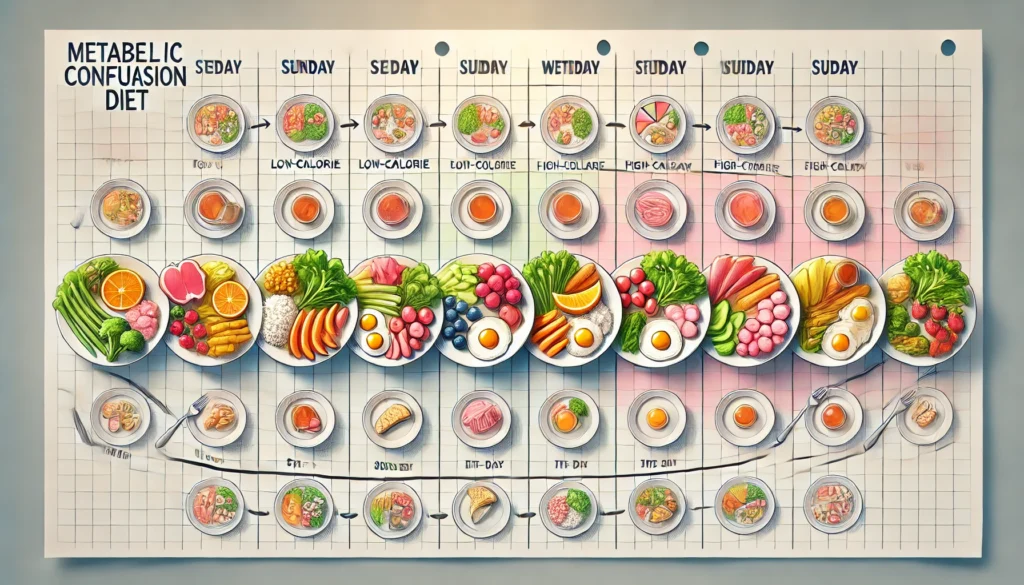Introduction
In the ever-evolving world of nutrition and weight loss science, one term that has gained notable attention is metabolic confusion. Also referred to as calorie cycling or calorie shifting, this strategy hinges on the principle that alternating calorie intake disrupts metabolic adaptation, thereby promoting sustained fat loss. While conventional dieting methods often lead to plateaus and frustration, the metabolic confusion diet presents a novel approach that challenges the traditional concept of steady-state caloric restriction. It is rooted in the scientific understanding of metabolic flexibility, energy expenditure variability, and the body’s hormonal responses to food and activity.
You may also like: Do Carbs Cause Brain Fog? What Science Reveals About Carbohydrates and Mental Clarity
Millions of people struggle with maintaining long-term weight loss, not because they lack discipline, but because their metabolism gradually adapts to low calorie intake, slowing down energy expenditure and making further fat loss nearly impossible. This phenomenon, often referred to as “adaptive thermogenesis,” is where the metabolic confusion diet claims to offer a strategic advantage. Instead of eating the same amount of calories every day, followers rotate between high-calorie and low-calorie days or mix macronutrient compositions. This pattern intends to prevent the body from entering conservation mode, keeping the metabolism active and responsive.
The metabolic confusion diet plan has been especially appealing to those who’ve hit a plateau in traditional diets or are seeking a more dynamic, less monotonous method of fat loss. It’s also found traction among fitness professionals, influencers, and even nutritionists intrigued by the body’s remarkable adaptability. But how effective is it really? Can it stand up to the rigorous demands of science-based scrutiny? And what does an evidence-informed metabolic confusion meal plan actually look like?
This article dives deep into these questions and more. We’ll explore the physiology behind the diet, the ideal structure for alternating caloric intake, real-world applications, and whether there’s truth to the promise of sustained fat loss without rigid deprivation. From analyzing metabolic rate behavior on a metabolism day to breaking down how macronutrient timing plays a role, this guide offers a full-spectrum, research-informed look at one of the most intriguing dietary approaches in recent years.

What Is Metabolic Confusion?
Metabolic confusion is not a formal medical term but rather a popularized name for a diet approach that focuses on intentionally varying your daily calorie intake to prevent the metabolism from adapting. The theory is that by constantly “confusing” the metabolism with alternating energy demands, the body avoids the slowdown commonly seen in steady-state low-calorie diets.
In physiological terms, your metabolism is a complex system of chemical reactions that convert food into usable energy. It adapts quickly to changes in energy intake. For instance, when you consistently eat fewer calories, your body slows its metabolic rate to conserve energy—a survival mechanism inherited from times of food scarcity. This adaptation, while biologically smart, is frustrating for dieters.
The metabolic confusion diet works by leveraging this adaptability. Rather than keeping the body in a predictable low-energy state, it rotates between periods of higher calorie intake and lower calorie intake. This alternation may help maintain or even elevate basal metabolic rate (BMR), boost thermogenesis (caloric burn from food digestion), and prevent hormonal shifts that promote fat storage.
Although scientific research on metabolic confusion is still emerging, early studies suggest that calorie cycling can produce similar or greater fat loss compared to continuous calorie restriction, with better adherence and satisfaction. One 2014 study in The International Journal of Preventive Medicine found that alternating calorie intake resulted in significant reductions in body weight, body fat, and waist circumference, while preserving lean muscle mass.
While more data is needed, metabolic confusion taps into principles already supported by science—such as non-linear dieting, diet breaks, and hormonal variability. The key lies in its strategic use and individualized execution, which makes creating a sustainable metabolic confusion meal plan both a science and an art.

How Does the Metabolic Confusion Diet Work?
The core of the metabolic confusion diet plan involves strategic calorie variation—cycling between high-calorie and low-calorie days throughout the week or even within the same day. This fluctuation may help prevent the downregulation of thyroid hormones, maintain leptin sensitivity, and keep the metabolism in a more active state. Leptin, a hormone secreted by fat cells, plays a vital role in hunger regulation and energy balance. When calories are consistently low, leptin levels drop, slowing down fat metabolism and increasing appetite.
By incorporating high-calorie days periodically, you stimulate leptin production, restore metabolic hormones, and possibly reset your metabolic “set point.” This makes the body more willing to shed fat again after a period of adaptation. Low-calorie days then create the deficit needed for fat loss. The result is a dynamic push-and-pull system designed to outsmart the body’s homeostatic response.
On a practical level, the metabolic confusion diet often involves alternating between 3–4 low-calorie days (typically 25–35% lower than your maintenance level) and 2–3 higher-calorie or refeed days. These higher intake days can include more carbohydrates and dietary fats, which also replenish muscle glycogen stores and reduce perceived deprivation.
Some people also practice metabolism day splits within a single day—eating most of their calories in one meal, practicing intermittent fasting, or alternating macro compositions. While this adds flexibility and personalization, the primary structure of calorie variation remains the foundational mechanism.
From a behavioral perspective, metabolic confusion offers psychological relief. People are more likely to stick to a plan when they know periods of indulgence are built in. It reduces feelings of restriction, which in turn decreases binge-eating tendencies. The flexibility of this diet can improve compliance and motivation—factors often overlooked but crucial in long-term success.
Benefits of the Metabolic Confusion Approach
The appeal of metabolic confusion lies not only in its scientific rationale but in the practical benefits many followers report. These advantages include physiological, psychological, and behavioral gains that address common diet pitfalls.
One of the most significant benefits is its potential to prevent the dreaded weight loss plateau. Many traditional dieters find that despite early success, progress stalls after a few weeks. This plateau often results from a slowed metabolic rate and hormonal changes. The metabolic confusion diet, by design, mitigates these effects, keeping fat-burning mechanisms more responsive.
Another key advantage is the preservation of lean muscle mass. When calorie intake is chronically low, the body may begin breaking down muscle tissue for energy. By incorporating refeed days with sufficient protein and carbohydrates, the metabolic confusion diet supports muscle maintenance—a crucial factor in sustaining metabolic rate.
Many followers also report improved energy, mood, and workout performance. Unlike strict diets that leave people fatigued, metabolic confusion supports high-calorie days that can restore glycogen and provide the fuel necessary for exercise. This fuels better workouts and accelerates fat oxidation post-exercise.
Additionally, psychological benefits include reduced food obsession, better diet adherence, and a more flexible relationship with food. The built-in variation keeps meals exciting, reducing monotony and increasing sustainability. Rather than viewing certain foods as “off-limits,” individuals can plan their intake in a way that feels empowering.
Some studies have suggested that metabolic flexibility—the body’s ability to efficiently switch between burning carbs and fat for fuel—is enhanced by cyclical calorie and macronutrient changes. This adaptability is critical for metabolic health, fat loss, and reducing risk factors associated with insulin resistance.
While individual responses vary, the overarching benefit of the metabolic confusion meal plan is its alignment with how the human metabolism evolved: to adapt to variability, not constancy. It is not a diet of extremes but a method of metabolic cooperation.

Crafting a Metabolic Confusion Meal Plan
Designing a metabolic confusion meal plan requires personalization, awareness of caloric needs, and strategic scheduling. The first step is to determine your maintenance calorie level—the number of calories required to maintain your current weight. This can be calculated using formulas like the Mifflin-St Jeor equation or a metabolism tracking app.
Once maintenance calories are known, the next step is to assign intake targets for low-calorie and high-calorie days. For example, if your maintenance is 2,000 calories, low days might be around 1,400–1,500 calories, and high days around 2,200–2,400. The goal is to create a net deficit across the week while leveraging hormonal boosts from the high intake days.
Macronutrient distribution is also important. On low-calorie days, protein intake should be high to preserve muscle and reduce hunger. Carbohydrates may be lower to support fat oxidation. On higher-calorie days, carbs and fats can be increased moderately to boost insulin sensitivity and promote recovery.
Meal timing strategies can also be integrated. Some people incorporate intermittent fasting on low-calorie days, while others split their meals evenly. The key is to listen to the body, monitor results, and adjust accordingly.
A sample weekly structure might look like this:
Monday–Wednesday: Low-calorie, protein-dominant, moderate-fat meals
Thursday: High-calorie refeed, with balanced macros
Friday–Saturday: Moderate intake, flexible composition
Sunday (Metabolism Day): High-carb, high-calorie intake to boost leptin and glycogen stores
The metabolism day is essential. It serves as a deliberate refeed to keep hormonal balance in check. On this day, meals might include complex carbs like sweet potatoes, oats, quinoa, and fruits—paired with lean proteins and healthy fats.
Meal plans should also prioritize nutrient density, anti-inflammatory foods, and hydration. This supports digestive health and energy metabolism, especially during metabolic transitions.
Science Behind the Metabolism Day
The metabolism day in a metabolic confusion diet is more than a “cheat day.” It’s a scientifically grounded refeed period intended to strategically elevate certain hormones, reset glycogen stores, and sustain diet adherence. The physiological response to a high-calorie day is complex and includes shifts in leptin, ghrelin, thyroid hormones, and insulin sensitivity.
Leptin, often referred to as the “satiety hormone,” drops during calorie restriction, which can lead to increased hunger and reduced energy expenditure. A temporary spike in caloric intake can increase leptin, restoring appetite control and boosting metabolic rate. Similarly, thyroid hormone T3—essential for energy metabolism—also responds positively to periodic energy surpluses.
On a well-structured metabolism day, the body may respond by temporarily increasing thermogenesis—the process of burning calories to process food. This is particularly true for carbohydrate intake, which has a higher thermic effect than fats. Additionally, insulin sensitivity improves following carb-rich meals in healthy individuals, allowing more efficient nutrient uptake and less fat storage.
Psychologically, metabolism days provide relief from restriction, which improves mood, satisfaction, and long-term compliance. Unlike “cheat meals,” metabolism days are planned, intentional, and nutritionally balanced. They prevent the binge-restrict cycle that can derail traditional diets.
The timing of a metabolism day can vary. Some plans incorporate it weekly, others biweekly. The best frequency depends on the individual’s progress, stress levels, training load, and hormonal markers. When used correctly, metabolism days reinforce the core concept of metabolic confusion—keeping the body guessing to maximize adaptive potential.
Misconceptions and Criticisms of Metabolic Confusion
Despite its growing popularity, the metabolic confusion diet has its skeptics. Some nutrition experts argue that calorie cycling is no more effective than traditional calorie restriction when total energy balance is controlled. According to this view, weight loss boils down to a simple energy equation: calories in versus calories out.
While it’s true that total caloric deficit determines fat loss, this perspective overlooks the complexity of hormonal adaptation, metabolic downregulation, and behavioral sustainability. Metabolic confusion does not claim to defy thermodynamics—it seeks to optimize energy balance by accounting for the body’s adaptive responses.
Another misconception is that metabolic confusion promotes disordered eating. Critics argue that switching between high and low intake may reinforce binge-restrict patterns. However, when planned properly, the metabolic confusion meal plan is balanced and psychologically empowering. It teaches flexibility rather than rigidity.
Additionally, some people misinterpret the concept and eat inconsistently without structure. True metabolic confusion is not random eating; it is a calculated, cyclical system with defined parameters. Without proper planning, the benefits may be lost and replaced with metabolic stress.
Criticism also arises around the lack of long-term studies. While early research and anecdotal results are promising, more robust data is needed to confirm the diet’s efficacy across diverse populations. Nonetheless, its alignment with evolutionary biology and metabolic principles lends it credibility as a viable strategy when implemented correctly.

Who Should Try the Metabolic Confusion Diet?
The metabolic confusion diet is best suited for individuals who:
- Have plateaued on traditional diets
- Struggle with rigid food restrictions
- Want flexibility while still achieving fat loss
- Are active and want to fuel workouts efficiently
- Prefer dynamic eating routines over monotonous ones
It may not be ideal for people with disordered eating histories, severe metabolic conditions, or those who need strict medical supervision for diet. Pregnant or breastfeeding women should also consult healthcare providers before attempting any caloric cycling.
Those with conditions like hypothyroidism, insulin resistance, or adrenal fatigue may benefit, but need a customized approach. A professional evaluation of hormone levels, nutrient deficiencies, and stress markers is essential before starting.
Frequently Asked Questions
1. What is metabolic confusion and how is it different from traditional dieting?
Metabolic confusion is a diet approach that alternates between high- and low-calorie days to prevent metabolic slowdown. Unlike traditional diets that maintain a consistent caloric deficit, metabolic confusion introduces variability to keep the body’s energy-regulating systems adaptive and responsive. This strategy is intended to sustain fat loss, preserve lean muscle, and enhance hormonal balance. It also provides psychological relief from continuous restriction, which can improve long-term adherence and reduce diet fatigue. The method is flexible and designed to work with the body’s natural metabolic fluctuations rather than against them.
2. How many days should I follow low versus high calories in a metabolic confusion diet?
The ideal balance depends on your goals, activity level, and current body composition. A common ratio is three to four low-calorie days followed by two to three high-calorie days. Alternatively, some people follow weekly rotations, with five lower-calorie days and two higher-calorie days for refeeding. Others adjust intake daily based on workout intensity. The key is consistency within the cycle and a clear understanding of your maintenance calorie level. Monitoring progress and adjusting as needed is essential for sustained results and optimal hormonal response.
3. Can I build muscle while following a metabolic confusion meal plan?
Yes, it is possible to build or maintain muscle while following a metabolic confusion meal plan, especially if protein intake is kept high and strength training is consistent. The inclusion of high-calorie days provides energy and nutrients necessary for muscle repair and growth. Timing carbohydrate intake around workouts can enhance performance and recovery. It’s crucial to ensure that low-calorie days don’t drop too low in protein or compromise training capacity. A well-balanced plan that prioritizes nutrient timing, progressive overload, and recovery can support lean mass retention or even gains during a metabolic confusion cycle.
4. What can I eat on a metabolism day?
On a metabolism day, meals should include complex carbohydrates, lean proteins, and healthy fats. Ideal foods include oats, sweet potatoes, quinoa, fruits, legumes, eggs, lean meats, and fatty fish. The focus should be on whole, unprocessed ingredients that support hormonal balance and replenish glycogen stores. Avoid junk food or empty-calorie splurges. While metabolism days are higher in calories, they should still align with clean eating principles to prevent digestive stress or inflammation. Thoughtful planning ensures that metabolism days are productive, not counterproductive.
5. Is the metabolic confusion diet suitable for beginners?
Yes, beginners can benefit from the metabolic confusion diet as long as they understand the foundational principles and structure their plan carefully. It’s important for new users to calculate their maintenance calories, plan their meal rotation, and ensure nutritional adequacy. Beginners should start with a simple schedule, such as alternating every other day, and track energy levels, hunger, and performance. Working with a nutrition coach or using tracking apps can ease the learning curve. Starting slow and building confidence through small adjustments often leads to more sustainable results.
6. How quickly can I expect results with metabolic confusion?
Results vary by individual, but many people report noticeable changes in energy, appetite, and weight within two to four weeks. Early results may include reduced bloating, improved digestion, and enhanced workout capacity. Sustainable fat loss usually becomes evident after consistent application over six to eight weeks. The rate of progress depends on how well the plan is executed, the degree of caloric deficit, hormonal health, and lifestyle factors like sleep and stress. Avoid the temptation to rush outcomes—metabolic confusion is a long-term strategy for metabolic resiliency, not a quick fix.
7. Do I need to count macros on a metabolic confusion diet?
While not strictly necessary, tracking macronutrients can enhance results, especially for those with specific goals like muscle building or fat loss. Understanding your protein, carbohydrate, and fat intake helps optimize energy levels, satiety, and metabolic function. On low-calorie days, a high-protein focus is key, while high-calorie days can include more carbohydrates for recovery and hormonal stimulation. Many tracking apps simplify the process. Over time, some individuals transition to intuitive eating once they become familiar with portion sizes and food responses.
8. Can metabolic confusion help with hormone balance?
Yes, the metabolic confusion diet may support hormonal balance, particularly hormones related to appetite, fat storage, and metabolism. Periodic high-calorie days can help normalize leptin, ghrelin, thyroid hormones, and insulin sensitivity. This cyclical stimulation may prevent the hormonal disruptions commonly associated with chronic calorie restriction. However, for individuals with diagnosed endocrine disorders, it’s important to consult a healthcare provider. Tailoring the plan with professional guidance ensures that hormonal health is supported rather than compromised.
9. Is metabolic confusion backed by scientific research?
While the term “metabolic confusion” is not formally used in clinical literature, the underlying principles—calorie cycling, intermittent refeeding, and metabolic adaptation—are well-supported by research. Studies have shown that intermittent energy restriction can lead to equal or superior fat loss compared to continuous dieting, with greater adherence and metabolic health benefits. More robust, long-term trials are needed to fully validate metabolic confusion as a distinct diet category. Still, it remains a science-informed approach that integrates well-established principles of nutritional periodization.
10. Can I use intermittent fasting with metabolic confusion?
Yes, many people successfully combine intermittent fasting with the metabolic confusion diet. On low-calorie days, time-restricted eating windows can enhance fat oxidation and reduce appetite. On higher-calorie days, eating over a broader window supports muscle recovery and energy restoration. Combining the two methods can improve insulin sensitivity, enhance autophagy, and support flexible metabolism. However, careful planning is required to ensure adequate nutrient intake and avoid energy deficits that impair recovery. Individual response and lifestyle compatibility should guide whether this combination is appropriate.

Conclusion
The metabolic confusion diet represents a forward-thinking approach to weight loss and metabolic health, one that recognizes the body’s innate adaptability and leverages it for sustainable results. By alternating caloric intake and strategically incorporating refeed days, this diet helps prevent metabolic slowdown, preserve muscle mass, and promote hormonal balance. It challenges the rigidity of conventional diets and empowers individuals to take control of their health through flexible structure and personalized nutrition.
Whether you’re a seasoned athlete looking to break through a fat loss plateau or a beginner frustrated by stagnation, the metabolic confusion diet plan offers a viable, science-backed strategy. With thoughtful execution, including well-balanced meal planning, regular metabolism days, and alignment with physical activity, this approach supports not just body
Was this article helpful? Don’t let it stop with you. Share it right now with someone who needs to see it—whether it’s a friend, a colleague, or your whole network. And if staying ahead on this topic matters to you, subscribe to this publication for the most up-to-date information. You’ll get the latest insights delivered straight to you—no searching, no missing out.
Further Reading:
My Brain Is Fried: Scientific Reasons Your Mind Feels Overworked and What to Do About It
Metabolic Confusion Diet Plan: How to Boost Fat Loss With Science



